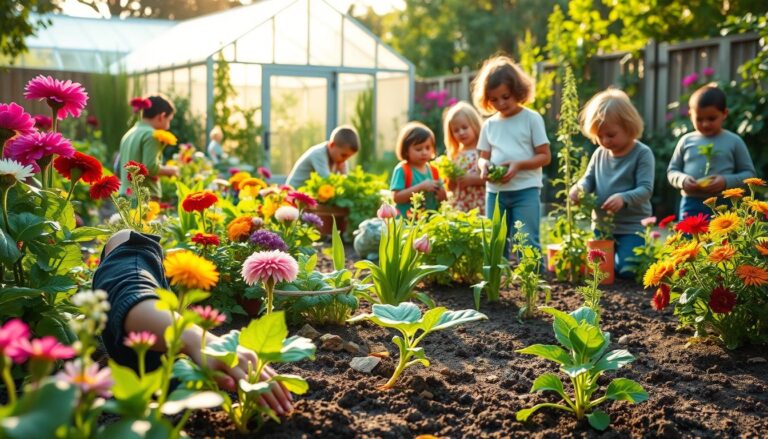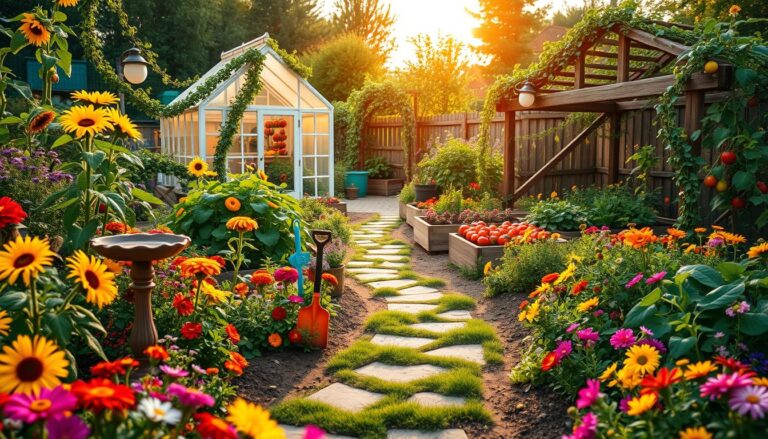Starting a herb garden can be very rewarding. It brings fresh flavors to your kitchen and adds greenery to your space. To succeed, you need to know the basics.
A successful herb garden starts with the right soil and containers. You also need enough sunlight and water for your plants.
By focusing on these key elements, you can grow a lot of your favorite herbs. Whether you’re new to gardening or have experience, the right herb garden kit essentials are crucial.
Understanding the Benefits of Growing Your Own Herbs
Having your own herb garden can make your cooking better, help with health, and save money. It lets you have fresh herbs right when you need them. This makes your meals taste better and be more nutritious.
Culinary Advantages of Fresh Herbs
Fresh herbs make dishes like soups and salads taste amazing. Using herbs from your garden can significantly enhance the flavor profile of your cooking. It also encourages you to try new recipes and flavors.
Medicinal Properties and Uses
Many herbs are good for your health. For example, chamomile helps you relax, and peppermint can help with digestion. Growing your own herbs means you always have these natural remedies on hand, helping you stay healthy.
Economic Benefits of Home Herb Gardens
Growing your own herbs can save you money. You won’t have to buy them as often, which can save you cash. Plus, it’s a green way to enjoy your favorite herbs without harming the environment.
| Benefit | Description | Advantage |
|---|---|---|
| Culinary | Enhances flavor and nutrition | Improves cooking experience |
| Medicinal | Provides natural remedies | Promotes health and well-being |
| Economic | Saves money on herb purchases | Cost-effective and sustainable |
Planning Your Herb Garden: Location and Layout
Starting an herb garden needs careful planning. You must pick the right spot and design a good layout. This ensures your herbs get enough sunlight and space to grow well.
Assessing Sunlight Requirements
Most herbs need plenty of sunlight to grow. The amount of sunlight needed varies among different herbs.
Full Sun Herbs
Herbs like basil and rosemary love full sun. They need at least 6 hours of direct sunlight every day.
Partial Shade Herbs
But, herbs like mint and parsley do well in partial shade. They’re good for spots with less direct sunlight.
Space Considerations for Different Garden Types
The layout of your herb garden should think about the size of the plants. It also depends on the type of garden you’re making. Make sure there’s enough room for air to move and for the plants to grow.
Companion Planting Strategies for Herbs
Companion planting can make your herbs grow better and taste better. For example, marigolds can keep pests away from your herbs. And basil can make tomatoes taste even better.
Herb Garden Essentials: Tools and Equipment
To have a thriving herb garden, you need more than just the right herbs. You also need the right tools and equipment. The right tools make gardening easier and more enjoyable.
Basic Hand Tools Every Herb Gardener Needs
Every herb gardener needs basic hand tools to keep their garden in top shape. These include:
- Pruning shears for trimming and shaping herbs.
- Gardening gloves to protect hands from thorns and dirt.
- Trowels for planting and transplanting herbs.
Pruning and Harvesting Tools
Pruning and harvesting are key for a healthy and productive herb garden. Pruning shears and scissors are must-haves. They help you trim plants and pick fresh herbs.
Planting and Maintenance Tools
For planting and caring for your herb garden, you’ll need tools like trowels and rakes. They help prepare the soil and keep it aerated for healthy roots.
Containers and Planters for Different Settings
The type of containers and planters you choose can greatly impact your herbs’ health and growth. Whether you’re gardening indoors or outdoors, picking the right containers is key.
For outdoor gardens, think about using terra cotta pots or wooden planters. For indoor gardens, self-watering planters are a great choice.
Watering Equipment Options
Watering your herb garden right is crucial. You have several options:
- Watering cans for a classic method.
- Drip irrigation systems for efficient watering.
- Spray bottles for gentle watering of seedlings.
Soil and Fertilizer Requirements for Herbs
Soil and fertilizer are key to a healthy herb garden. Knowing what your herbs need is essential for a good harvest.
Understanding Soil Types and pH Levels
Herbs do best in well-draining soil with a pH of 6.0 to 7.0. Testing your soil pH is the first step. Most herbs like slightly acidic to neutral soil.
Organic vs. Conventional Fertilizers for Herbs
Choosing between organic and conventional fertilizers depends on your gardening style. Organic fertilizers, like compost, feed plants slowly and improve soil. Conventional fertilizers give quick nutrients but can harm soil if used too much.
“The use of organic fertilizers not only nourishes the plants but also enhances the soil’s biodiversity.”
Creating the Perfect Potting Mix
A great potting mix is crucial for container gardens. It should hold moisture but drain excess water to avoid root rot.
Indoor Potting Mix Recipes
For indoor herbs, mix peat moss, perlite, and vermiculite for a balanced mix. Adding compost boosts nutrient levels.
Outdoor Soil Amendments
Outdoor gardens benefit from compost or well-rotted manure. These improve soil fertility and drainage.
By choosing the right soil and fertilizer, you can make your herb garden healthier and more productive. This ensures a steady supply of fresh herbs for cooking and medicine.
The Best Herbs to Grow for Beginners
Starting with herb gardening? Choosing the right herbs is key. Growing herbs at home is rewarding. Begin with the best herbs to grow for a great start.
Easy-to-Grow Culinary Herbs
Culinary herbs are perfect for beginners. They’re easy to grow and add flavor to many dishes. Here are some favorites:
Basil, Parsley, and Chives
Basil is a must-have for Italian and Thai cooking. Parsley is great as a garnish or in salads. Chives add a mild onion taste to dishes.
Thyme, Rosemary, and Oregano
Thyme is easy to care for and good in soups and stews. Rosemary has a piney flavor, perfect for roasted dishes. Oregano is essential in Mediterranean cooking, great in pizzas and pasta sauces.
Low-Maintenance Medicinal Herbs
Medicinal herbs are great for your garden and health. Calendula helps with skin issues, and Chamomile calms you down. They’re easy to grow and useful in teas and salves.
Aromatic Herbs for Garden Beauty
Aromatic herbs like Lavender and Lemongrass make your garden beautiful and fragrant. They’re easy to care for. Use them in potpourri and crafts. They also attract good insects.
How to Start an Herb Garden: Step-by-Step Guide
Starting an herb garden is easy and rewarding. Just follow a few simple steps to ensure success.
Starting from Seeds vs. Seedlings
Choosing between seeds and seedlings is your first decision. Seeds are cheaper and offer more variety. But, seedlings grow faster and are easier to care for.
Think about these points when picking seeds or seedlings:
- Time: Seeds grow slower than seedlings.
- Cost: Seeds are cheaper than seedlings.
- Variety: Seeds have more herb options.
Proper Planting Techniques
After choosing, it’s time to plant. Good planting habits are key for a healthy garden.
Spacing Guidelines
Space herbs right to avoid crowding. Most need 6-12 inches between them, based on the type.
Planting Depth Considerations
Plant depth varies by herb. Seeds should be planted 2-3 times their size deep. For seedlings, dig a hole as deep as the pot and wider.
| Herb Type | Spacing | Planting Depth |
|---|---|---|
| Basil | 6-8 inches | 1/4 inch (seeds) |
| Cilantro | 2-3 inches | 1/4 inch (seeds) |
| Rosemary | 12-18 inches | Same depth as container (seedlings) |
Initial Care After Planting
After planting, herbs need the right care. Keep the soil moist for a few weeks. Most herbs need 4-6 hours of sunlight daily.
Indoor Herb Garden Considerations
Indoor herb gardens let you grow your favorite herbs all year, no matter the weather outside. To make sure they thrive, you need to think about a few important things.
Lighting Solutions for Indoor Herbs
Good lighting is key for indoor herbs to grow well. You have two main options: natural light and artificial light.
Natural Light Positioning
Herbs do best near a south-facing window for natural light. But, direct sunlight can be too strong. A sheer curtain can help soften the light.
Artificial Lighting Options
If your room gets little natural light, LED grow lights are a great choice. They use less energy and give the right light for herbs to grow.
Temperature and Humidity Control
Most herbs like daytime temperatures between 65-75°F (18-24°C) and cooler nights. Keeping humidity low, around 40-50%, helps avoid fungal diseases.
Space-Saving Indoor Herb Garden Ideas
If you have little space, there are smart ways to garden indoors. Use vertical gardens, hanging planters, or tiered shelves to save space and add style to your home.
| Herb | Lighting Needs | Temperature Preference |
|---|---|---|
| Basil | High | 65-75°F |
| Mint | Medium | 60-70°F |
| Rosemary | High | 65-75°F |
Outdoor Herb Garden Success Strategies
An outdoor herb garden can be a lush and productive part of your home. To make it happen, focus on the garden’s layout, protecting it from weather, and managing pests.
Raised Beds vs. In-Ground Planting
Choosing between raised beds and in-ground planting is important. Raised beds drain better and warm up faster, great for herbs. In-ground planting is cheaper and might need less soil work.
Weather Protection Strategies
Herbs face many weather challenges like cold, rain, and dry spells. Use row covers to protect from frost and wind. Mulching keeps soil moist and stops weeds.
Pest Management in Outdoor Settings
Keeping pests away is key for a healthy outdoor herb garden. Spot common pests early and use natural ways to control them.
Common Herb Garden Pests
Aphids, spider mites, and slugs are common pests. Watch your garden closely to catch them early.
Natural Pest Control Methods
Use natural methods like introducing beneficial insects or neem oil sprays. They keep pests in check without harming the environment.
| Pest | Natural Control Method | Effectiveness |
|---|---|---|
| Aphids | Neem Oil Spray | High |
| Spider Mites | Beneficial Insects | Medium |
| Slugs | Copper Barriers | High |
With these strategies, your outdoor herb garden will thrive. It will give you fresh herbs all season long.
Seasonal Care and Maintenance of Herb Gardens
As the seasons change, so do the needs of your herb garden. To keep your garden thriving, you must understand and adapt to these changes. This ensures your plants stay healthy and productive.
Seasonal adjustments are key for growing herbs at home. Each season brings its own set of challenges and opportunities for herb garden care.
Spring and Summer Herb Care
In spring and summer, herbs grow fast. Make sure they get enough sunlight and water. Prune them often to keep them bushy and prevent flowering.
Basil and mint love warm weather and need lots of water.
Fall Preparation and Harvesting
When fall comes, get your garden ready for the cold. Pick your herbs often to make them grow again before the frost. Move sensitive herbs indoors or cover them with mulch or covers.
Winter Protection and Indoor Transition
In winter, many herbs need protection from frost. Some can be brought indoors or moved to a greenhouse. For those outside, add mulch or straw to keep roots warm.
Use containers that can be moved to safe places during bad weather.
By following these seasonal care tips, you can enjoy herbs all year. Remember, the secret to a successful herb garden is to adjust to your plants’ changing needs with the seasons.
“A garden requires patience and observation.” –
Must-Have Herb Garden Supplies for Long-Term Success
A well-stocked herb garden is key to long-term success. You need the essential tools and supplies for your plants’ growth. These supplies help your garden thrive.
Quality Seeds and Plant Sources
The journey to a successful herb garden starts with quality seeds and plant sources. Choose reputable suppliers for healthy, robust herbs. Look for a variety of seeds and plants and read reviews to check reliability.
Sustainable Gardening Supplies
Sustainable gardening supplies are good for the environment and your garden. Use biodegradable pots, organic fertilizers, and eco-friendly pest control. Sustainable choices help your garden and the planet.
Record-Keeping and Garden Planning Tools
Record-keeping and garden planning tools are crucial for tracking your garden’s progress. Use garden journals, mobile apps, or spreadsheets for planting dates, harvests, and weather. Detailed records help you improve your gardening skills over time.
Harvesting and Using Your Herbs
Harvesting herbs is more than picking leaves. It’s an art that needs timing and technique for the best taste and smell. By learning how to harvest, you can enjoy your herbs all year. You can use them fresh, dried, or preserved.
Proper Harvesting Techniques
To harvest herbs well, you need to know when and how. This ensures quality and helps the plant grow back.
When to Harvest Different Herbs
Each herb has its best time to harvest. For example, mint and lemongrass are best in the morning. This is after dew has gone but before it gets hot. Knowing this is key to tips for successful herb gardening.
Cutting Methods for Maximum Regrowth
Using the right tools and methods helps herbs grow back. For example, cutting off flower buds helps herbs like basil and cilantro grow more leaves.
Preserving Methods for Different Herbs
Preserving herbs lets you enjoy them all year. Different herbs need different ways to preserve. For example, drying works well for oregano and thyme. But freezing is better for parsley and dill. You can even freeze mint in ice cube trays for later use in drinks and food.
Creative Ways to Use Your Herb Harvest
The best herbs to grow are those you use a lot in cooking. Think about what you like to eat. For Italian food, basil and oregano are essential. Use fresh herbs to flavor soups, salads, and sauces. Or dry them for teas and seasonings.
Conclusion: Enjoying the Rewards of Your Herb Garden
Now that you know herb garden essentials and how to start an herb garden, you’re set. Growing your own herbs is rewarding. It adds fresh flavors to your cooking and a sense of pride as you care for your plants.
Creating a thriving herb garden takes planning. You need to pick the right spot and herbs for your needs. By following this guide, you’ve started on the path to a harvest of fresh, fragrant herbs.
Herbs bring joy in many ways. They enhance your cooking, offer health benefits, and add beauty to your garden. So, enjoy the flavors and benefits of your herb garden. Happy gardening!
FAQ
What are the essential tools for herb gardening?
How often should I water my herb garden?
What are the best herbs to grow for beginners?
How can I protect my outdoor herb garden from pests?
Can I grow herbs indoors during the winter?
How do I harvest herbs without damaging the plant?
What is the best way to preserve fresh herbs?
How can I create a sustainable herb garden?

Sortemdia nasceu com o propósito de trazer alegria e oportunidades para todos por meio de sorteios gratuitos de prêmios incríveis. O site tem como missão oferecer experiências acessíveis, divertidas e justas para quem deseja concorrer a produtos, serviços e brindes sem pagar nada por isso. Acreditamos que a sorte pode bater à porta de qualquer pessoa — e no Sortemdia, ela pode chegar com apenas um clique.



